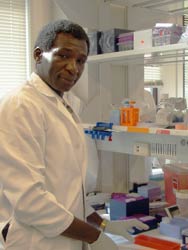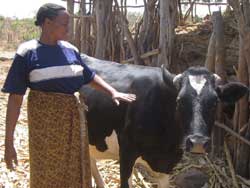Combating sleeping sickness in Kenya
April 2010 | Volume 9, Issue 2
Dr. Johnson Ouma
Deputy Center Director and Principal Research Officer,
Trypanosomiasis Research Center of the Kenya Agricultural Research Institute
“Stories my dad told me of misery inflicted upon our people - and their livestock - by tsetse flies and trypanosomiasis inspired me at an early age to study science so I could find ways of controlling this menace,” says former Fogarty trainee Dr. Johnson Ouma, who studies the genetics of tsetse populations to improve methods of control.
More than two-thirds of Kenyan land is tsetse-infested. Tsetse flies transmit human African trypanosomiasis, called sleeping sickness because it eventually causes sleep disorders. Trypanosomiasis also affects livestock, causing a related debilitating disease that impacts the availability of milk and meat for the rural poor.
There are no vaccines for this potentially fatal illness, but it can be treated if diagnosed early. Treatment isn’t easy: the drugs have high toxicity. Unfortunately, cases of parasite resistance are on the increase.

Photo courtesy of Dr. Ouma
With Fogarty support, Dr. Johnson
Ouma studied genetics at Yale
University.
With Fogarty support, Ouma was a junior faculty trainee during the summer of 2009 at Yale University’s School of Public Health, mentored by Dr. Serap Aksoy and Dr. Adagalsia Caccone. He worked for them as a trainee at the Trypanosomiasis Research Center, where they are coinvestigators on a capacity-building project under Fogarty’s Global Infectious Disease Research Training Program.
At Yale, Ouma conducted experiments on tsetse population genetics with Caccone. He advanced his understanding of genotyping, increased his knowledge of how to format data, and learned to use different kinds of population genetics software that he could apply to his work at home.
After the course ended, Ouma helped organize and conduct a training workshop on vector biology in Kampala, Uganda. At that meeting, he received a scientific merit award from the African Union’s International Scientific Council for Trypanosomiasis Research and Control.

Dr. Ouma's work in population genetics helps
characterize relationships among seemingly
isolated groups of tsetse and contributes to
the design of more effective control
strategies in Kenya.

Photo by Bev Abma, USAID
More than two-thirds of Kenyan land is
tsetse-infested. The flies transmit human
African trypanosomiasis, also called sleeping
sickness. Livestock get infected with a related
disease that reduces milk and meat for the
rural poor.
The specific focus of Ouma’s work is the population biology of tsetse flies, learning how far and wide the populations move, and if seemingly isolated groups are genetically related. Tsetse control using traps and insecticide-impregnated targets have been unsustainable after the inevitable resurgence of tsetse. To understand past control failures, Ouma is pursuing several research questions: did tsetse from other populations re-invade cleared areas? If so, what are the likely sources of re-infestation? How isolated are tsetse populations?
Data he generated led to co-authorship of a paper about control of tsetse that was published recently by PLoS Neglected Tropical Diseases. Population genetics helps characterize linkage among apparently isolated groups of tsetse and contributes to the design of more effective control strategies, the ultimate goal of the research.
Soon after he returned to Kenya, Ouma was promoted to principal research scientist at the government’s Trypanosomiasis Research Center where he is deputy center director. And at Kenya’s Maseno University, Ouma is an honorary assistant professor of zoology. He currently mentors and advises seven graduate students.
“My goal is to become a full university professor or director of a successful national or regional research institution, providing progressive leadership in scientific research on trypanosomiasis and other neglected vector-borne tropical diseases,” says Ouma.
Phylogeography and population structure of Glossina fuscipes in Uganda: implications for control of tsetse. Beadell JS, Hyseni C, Abila P, Azabo R, Enyaru JCK, Ouma JO, Mohammed YO, Okedi LM, Aksoy S, Caccone A. PLoS Neglected Tropical Diseases 4(3): e636. i:10.1371/journal.pntd.0000636.
To view Adobe PDF files,
download current, free accessible plug-ins from Adobe's website.